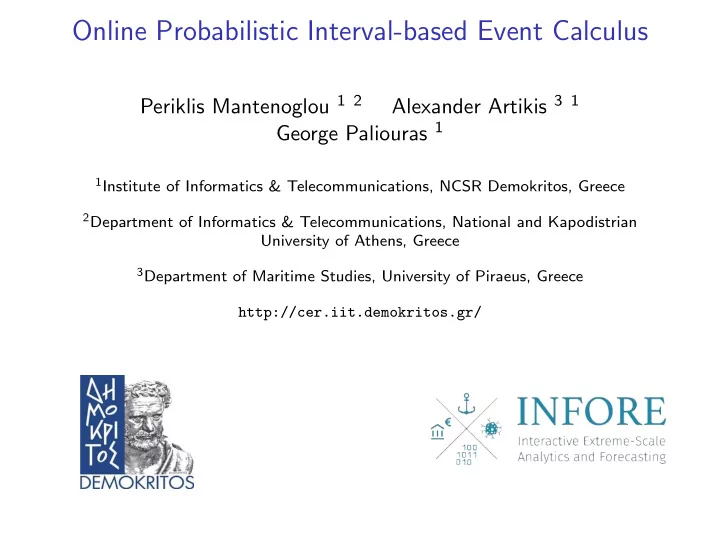

Online Probabilistic Interval-based Event Calculus Periklis Mantenoglou 1 2 Alexander Artikis 3 1 George Paliouras 1 1 Institute of Informatics & Telecommunications, NCSR Demokritos, Greece 2 Department of Informatics & Telecommunications, National and Kapodistrian University of Athens, Greece 3 Department of Maritime Studies, University of Piraeus, Greece http://cer.iit.demokritos.gr/
Event Calculus • A logic programming language for representing and reasoning about events and their effects. • Constituents: • events. • time model of integer time-points. • fluents: time varying properties, effected by event occurrences. • Built-in representation of inertia: • F = V holds at a particular time-point if F = V has been initiated by an event at some earlier time-point, and not terminated by another event in the meantime. 1
Event Calculus in Human Activity Recognition Rules for the ‘moving together’ long-term activity: initiatedAt ( moving ( P 1 , P 2 ) = true , T ) ← happensAt ( walking ( P 1 ) , T ), happensAt ( walking ( P 2 ) , T ), holdsAt ( close ( P 1 , P 2 ) = true , T ), holdsAt ( similarOrientation ( P 1 , P 2 ) = true , T ). terminatedAt ( moving ( P 1 , P 2 ) = true , T ) ← happensAt ( walking ( P 1 ) , T ), holdsAt ( close ( P 1 , P 2 ) = false , T ). 2
Prob-EC: Human Activity Recognition sarah begins walking with mike sarah walks away sarah is active, from mike sarah walks with mike continues mike again walking 1 21 2 41 Moving Probability 0.8 Moving repeatedly Moving repeatedly initiated terminated Moving Moving persists initiated through inertia 0.32 once Video Frames Input of Simple Events 0.70::happensAt(walking(mike), 1). 0.69::happensAt(walking(mike), 21). 0.46::happensAt(walking(sarah), 1). 0.58::happensAt(walking(sarah), 21). 0.73::happensAt(walking(mike), 2). 0.18::happensAt(inactive(mike), 41). 0.55::happensAt(active(sarah), 2). 0.32::happensAt(walking(sarah), 41). 3
PIEC: Probabilistic Interval-based Event Calculus 4
Interval Probability Interval Probability The probability of interval I CE =[ i , j ] with length ( I CE ) = j − i + 1 timepoints is defined as � j k = i P ( holdsAt ( CE = true , k )) P ( I CE ) = . length ( I CE ) Probabilistic Maximal Interval (PMI) An interval I =[ i , j ] is probabilistic maximal interval if: 1 P ( I ) ≥ T . 2 There is no interval I ′ : P ( I ′ ) ≥ T and I ⊂ I ′ 5
Interval Computation Input: A temporally sorted array of probabilities of a CE. Output: A collection of probabilistic maximal intervals. • Let t s , t e two indices of the input array. • PIEC computes prefix [ t ] = � t i = 0 ( P ( i ) − T ) for each index. • If prefix [ t e ] − prefix [ t s − 1 ] ≥ 0 , then P ( I = [ t s , t e ]) ≥ T . • Then, PIEC computes every probabilistic maximal interval of the input in linear-time. 6
Online PIEC 7
Online PIEC 8
Online PIEC 9
Interval Computation – Support Set • oPIEC computes the potential starting points of future intervals. • The support set stores these starting points. • Each starting point t s is accompanied by the score value score [ t s ] = prefix [ t s − 1 ] = � t s − 1 i = 0 ( P ( i ) − T ) used for interval computation. • If prefix [ t e ] − score [ t s ] ≥ 0 , then P ( I = [ t s , t e ]) ≥ T . 10
oPIEC b : A Bounded memory version • To support online reasoning, the support set must be bounded. • oPIEC deletes the time-points with the lowest likelihood. Support Set Maintenance Given the support set [( t 0 , score [ t 0 ]) , . . . , ( t m , score [ t m ])], oPIEC b computes the likelihood L of the starting point t i as L [ t i ] = score [ t i − 1 ] − score [ t i ] . 11
Empirical Analysis: Experimental Setup • Empirical Analysis on CAVIAR, a benchmark dataset for human activity recognition. • CAVIAR has been injected with artificial noise; We used a ‘smooth noise’ and a ‘strong noise’ version. • The target CEs are: ‘moving together’, ‘meeting’ and ‘fighting’. 12
Online to Batch System Comparison 1 1 0 . 9 0 . 9 f1-score f1-score 0 . 8 0 . 8 oPIEC b oPIEC b Naive oPIEC b Naive oPIEC b 0 . 7 0 . 7 0 50 100 150 0 50 100 150 support set size support set size ‘Meeting’ activity; ‘smooth ‘Meeting’ activity; ‘strong noise’. noise’. 13
Evaluation against the Ground Truth 0 . 9 0 . 8 f1-score 0 . 7 oPIEC b with batch size = 1 oPIEC b with batch size = 10 PIEC Prob-EC 0 . 6 0 50 100 150 support set size ‘Fighting’ activity; ‘smooth ‘Meeting’ activity; ‘strong noise’. noise’. 14
Summary and Future Work Summary oPIEC: • supports online interval-based CER. • guarantees correct interval computation by identifying every potential starting point of a CE in a stream. • introduces an effective memory maintenance method for storing potential starting points. Future Work • New support set maintenance methods. • oPIEC on maritime data. 15
Recommend
More recommend